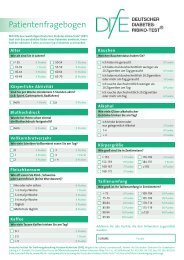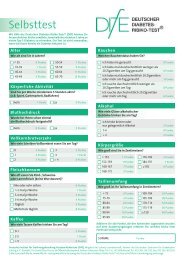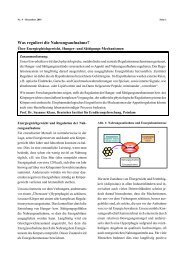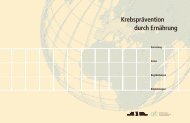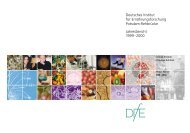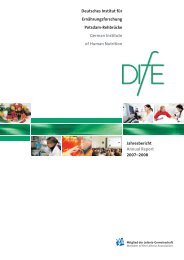BB - DIfE
BB - DIfE
BB - DIfE
Erfolgreiche ePaper selbst erstellen
Machen Sie aus Ihren PDF Publikationen ein blätterbares Flipbook mit unserer einzigartigen Google optimierten e-Paper Software.
32<br />
�3 Mortality risk and alcohol consumption<br />
can be predicted better with the waisthip<br />
ratio than with BMI, whereas BMI<br />
seems to be a good risk predictor in<br />
men.<br />
Further, our data show that alcohol consumption<br />
is associated with risk for cancer<br />
of the upper gastrointestinal tract,<br />
whereas the risk with wine is lower than<br />
with beer or liquor. In addition, the<br />
mortality risk increases with a lifelong<br />
alcohol consumption of more than<br />
60 g/d; former drinkers also possess this<br />
increased mortality risk (Tab. �3 ).<br />
The department contributes to other<br />
EPIC publications by providing information<br />
about cancer incidence and<br />
lifestyle changes to the central database<br />
and by assisting in data analysis and<br />
manuscript preparation. A publication<br />
on meat consumption and cancer risk is<br />
an example.<br />
Cardiovascular diseases<br />
The Department of Epidemiology is<br />
conducting in cooperation with the<br />
<strong>DIfE</strong> Department of Clinical Nutrition,<br />
the University of Magdeburg, and the<br />
Molecular Network of the University of<br />
Kiel an extensive research program to<br />
characterize risk factors of cardiovascular<br />
diseases. These investigations include<br />
questionnaire data and biochemical<br />
parameters of the EPIC-Potsdam cohort<br />
and the EPIC Study as a whole. In<br />
the EPIC-Potsdam cohort, we identified<br />
243 medically verified myocardial infarctions<br />
and 211 strokes up to October<br />
2006.<br />
At first, we investigated classical risk factors<br />
such as hypertension, diabetes<br />
mellitus, smoking, physical inactivity,<br />
and obesity for their roles in the occurrence<br />
of myocardial infarction. Besides<br />
investigating single factors, we used an<br />
innovative approach to identify the role<br />
of specific combinations of risk factors.<br />
The joint prevalence of physical inactivity,<br />
hypertension, and smoking increased<br />
the relative risk of myocardial<br />
infarction in the EPIC-Potsdam Study by<br />
a factor of 6.6 whereas with the combination<br />
physical inactivity, hypertension,<br />
and obesity, the factor was only 2.5.<br />
We also investigated the association<br />
between the risk of myocardial infarction<br />
or stroke and plasma levels of certain<br />
biomarkers, for example resistin, a<br />
new marker of inflammation, and<br />
homocysteine. First results in respect to<br />
homocysteine, folic acid, vitamin B12,<br />
Alkoholkonsum (g/Tag)/ Anzahl der Personenjahre/ Relatives Sterberisiko1 Alcohol consumption (g/day) Verstorbenen/ Person-years (95 % Konfidenz-<br />
Number of deaths intervall)/<br />
Mortality risk1 Frauen/Women<br />
(95 % confidence<br />
interval)<br />
Kein/None 649 196708 1.25 (1.13–1.37)<br />
Vor dem Aufhören/<br />
Before quitting<br />
0.1–15.0<br />
432 89749 1.32 (1.18–1.47)<br />
Vor dem Aufhören/<br />
Before quitting<br />
>15.0<br />
35 4789 2.22 (1.58–3.12)<br />
Lebenslang/Lifelong<br />
0.1–5.0<br />
2488 839414 1<br />
Lebenslang/Lifelong<br />
5.1–15.0<br />
1703 617768 0.96 (0.90–1.02)<br />
Lebenslang/Lifelong<br />
15.1–30.0<br />
632 220461 1.06 (0.96–1.17)<br />
Lebenslang/Lifelong<br />
30.1–60.0<br />
133 44134 1.12 (0.93–1.35)<br />
Lebenslang/Lifelong<br />
>60<br />
Männer/Men<br />
17 4576 1.42 (0.88–2.30)<br />
Kein/None 91 10776 1.14 (0.91–1.42)<br />
Vor dem Aufhören/<br />
Before quitting<br />
0.1–15.0<br />
316 22748 1.35 (1.17–1.55)<br />
Vor dem Aufhören/<br />
Before quitting<br />
>15.0<br />
151 8937 2.23 (1.84–2.69)<br />
Lebenslang/Lifelong<br />
0.1–5.0<br />
755 93523 1<br />
Lebenslang/Lifelong<br />
5.1–15.0<br />
1312 202125 0.90 (0.82–0.99)<br />
Lebenslang/Lifelong<br />
15.1–30.0<br />
1173 196159 0.93 (0.84–1.04)<br />
Lebenslang/Lifelong<br />
30.1–60.0<br />
942 144981 1.06 (0.94–1.19)<br />
Lebenslang/Lifelong<br />
60.1–120.0<br />
397 49561 1.35 (1.16–1.56)<br />
Lebenslang/Lifelong<br />
>120.0<br />
99 9850 1.78 (1.40–2.25)<br />
1 Multivariable adjustiert/Multivariable adjusted<br />
�3 Gesamtsterblichkeit und Alkoholkonsum<br />
werden, dass das Sterberisiko bei lebenslangem<br />
Alkoholkonsum von über 60 g/Tag<br />
ansteigt und dass auch Extrinker diesem<br />
erhöhtem Sterberisiko unterliegen<br />
(Tab. �3 ).<br />
Die Abteilung beteiligt sich zudem an<br />
anderen, die Krebserkrankungen betreffenden<br />
EPIC-Publikationen, indem sie<br />
Informationen über Krebsneuerkrankungen<br />
und Lebensstilveränderungen an die<br />
zentrale Datenbank liefert und bei der<br />
Datenauswertung und dem Überarbeiten<br />
von Manuskripten mitwirkt. Beispiele<br />
hierfür wären Publikationen zum Thema<br />
Fleischkonsum und Krebsrisiko.<br />
Herz-Kreislauf-Erkrankungen<br />
Dagmar Drogan, Kerstin Klipstein-Grobusch,<br />
Tobias Pischon, Cornelia Weikert<br />
Zur Charakterisierung der Risikofaktoren<br />
von Herz-Kreislauf-Erkrankungen hat die<br />
Abteilung Epidemiologie in Zusammenarbeit<br />
mit der Abteilung Klinische Ernährung<br />
des <strong>DIfE</strong>, der Universität Halle/<br />
Magdeburg und des Molekularen Netzwerkes<br />
der Universität Kiel inzwischen<br />
ein umfangreiches Forschungsprogramm<br />
implementiert. Unsere Untersuchungen<br />
führen wir basierend auf Fragebogendaten<br />
und biochemischen Parametern an





